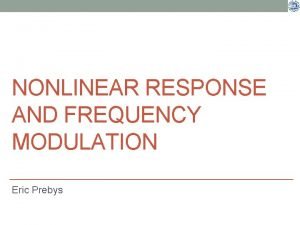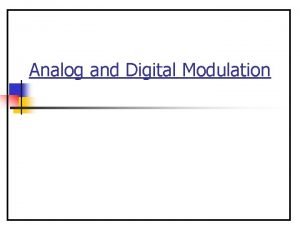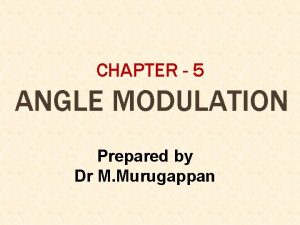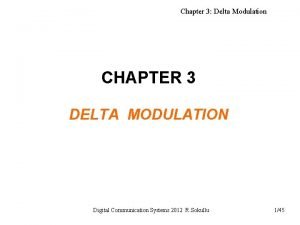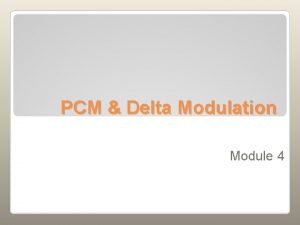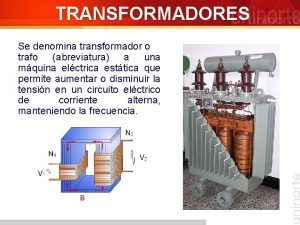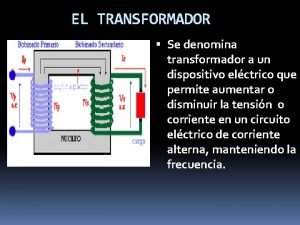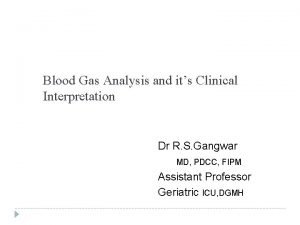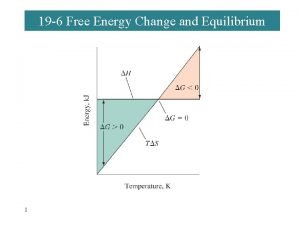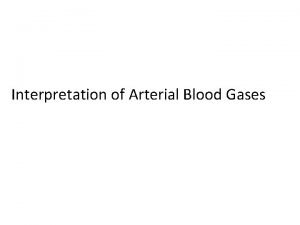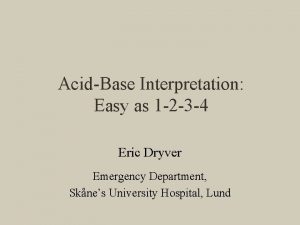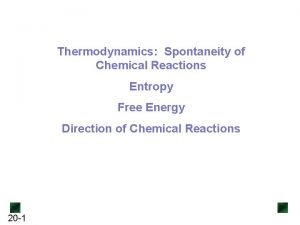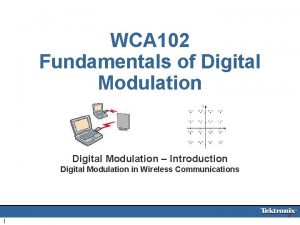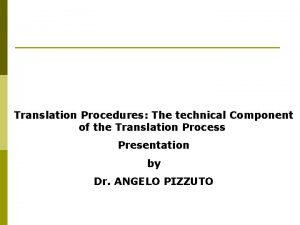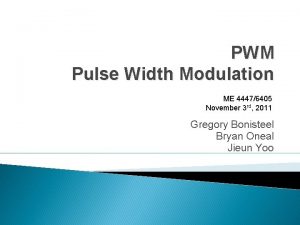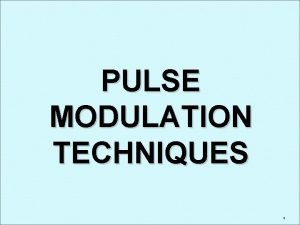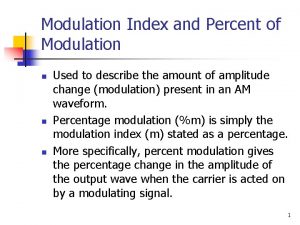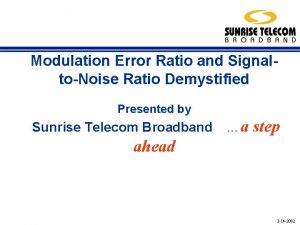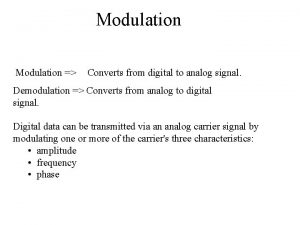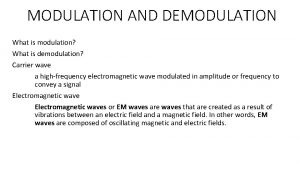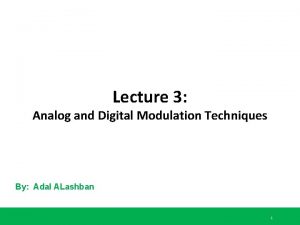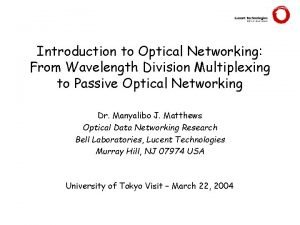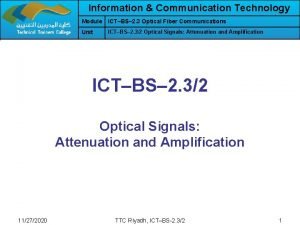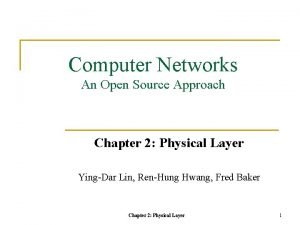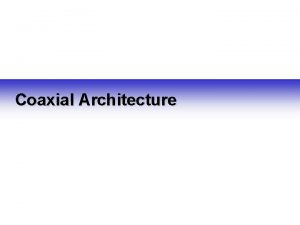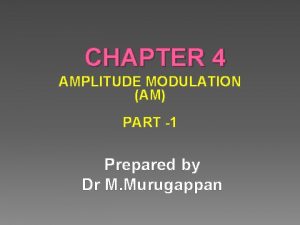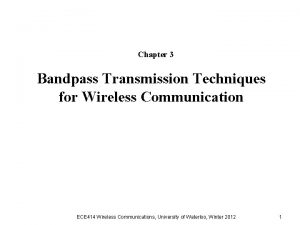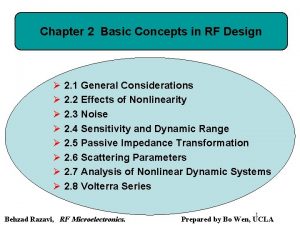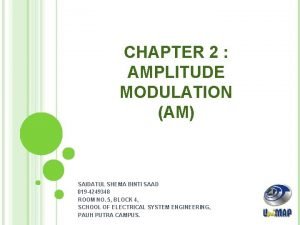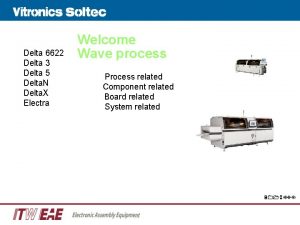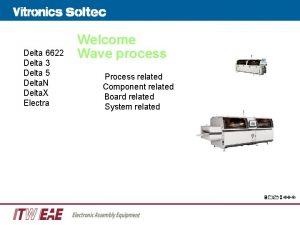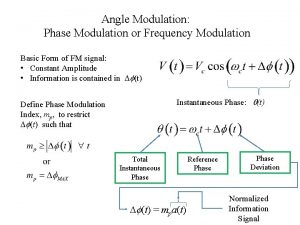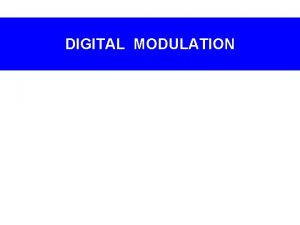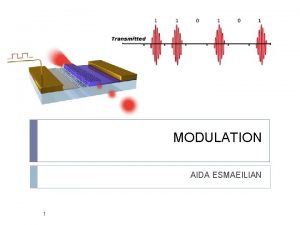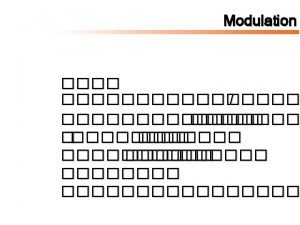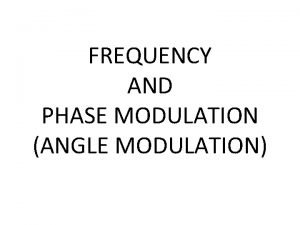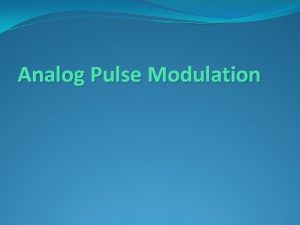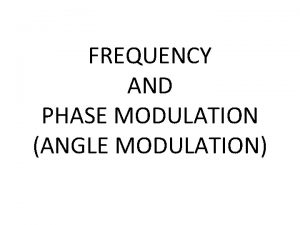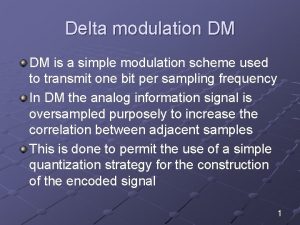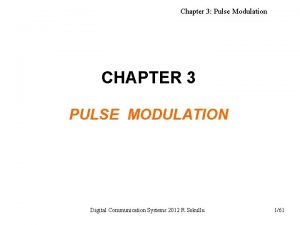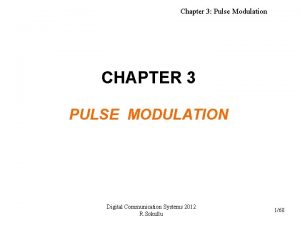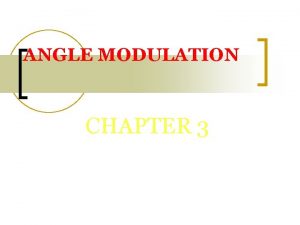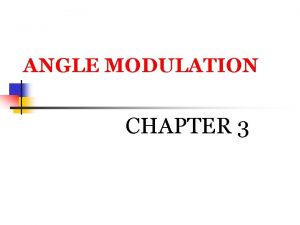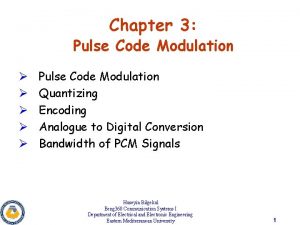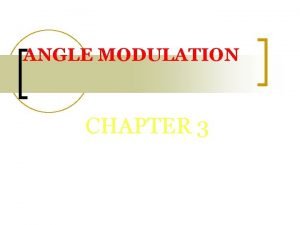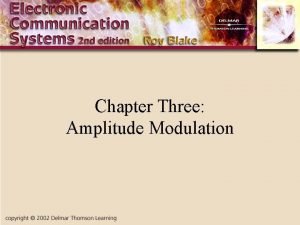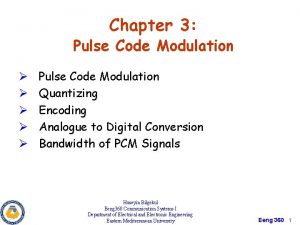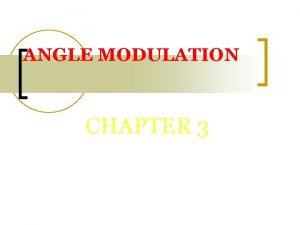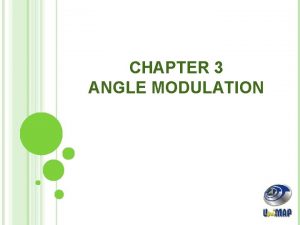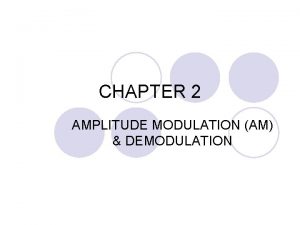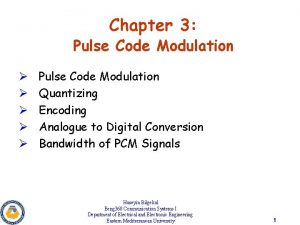Chapter 3 Delta Modulation CHAPTER 3 DELTA MODULATION






























![Chapter 3: Delta Modulation Details – cont’d • mq[n] is the quantized version of Chapter 3: Delta Modulation Details – cont’d • mq[n] is the quantized version of](https://slidetodoc.com/presentation_image_h/115d4a540b876d4c6c03721466e7dd08/image-31.jpg)













- Slides: 44

Chapter 3: Delta Modulation CHAPTER 3 DELTA MODULATION Digital Communication Systems 2012 R. Sokullu 1/45

Chapter 3: Delta Modulation Outline • 3. 12 Delta Modulation Delta Sigma Modulation • 3. 13 Linear Prediction • 3. 14 Differential Pulse Code Modulation • 3. 15 Adaptive Differential Pulse Code Modulation Digital Communication Systems 2012 R. Sokullu 2/45

Chapter 3: Delta Modulation 3. 12 Delta Modulation • Definition: Delta Modulation is a technique which provides a staircase approximation to an over-sampled version of the message signal (analog input). • sampling is at a rate higher than the Nyquist rate – aims at increasing the correlation between adjacent samples; simplifies quantizing of the encoded signal Digital Communication Systems 2012 R. Sokullu 3/45

Chapter 3: Delta Modulation Illustration of the delta modulation process Figure 3. 22 Digital Communication Systems 2012 R. Sokullu 4/45

Chapter 3: Delta Modulation Principle Operation • message signal is over-sampled • difference between the input and the approximation is quantized in two levels - +/-Δ • these levels correspond to positive/negative differences • provided signal does not change very rapidly the approximation remains within +/-Δ Digital Communication Systems 2012 R. Sokullu 5/45

Chapter 3: Delta Modulation Assumptions and model We assume that: • m(t) denotes the input message signal • mq(t) denotes the staircase approximation • m[n] = m(n. Ts), n = +/-1, +/-2 … denotes a sample of the signal m(t) at time t=n. Ts, where TS is the sampling period • then Digital Communication Systems 2012 R. Sokullu 6/45

Chapter 3: Delta Modulation • we can express the basic principles of the delta modulation in a mathematical form as follow: error signal quantized output Digital Communication Systems 2012 R. Sokullu 7/45

Chapter 3: Delta Modulation Pros and cons • Main advantage – simplicity • Sampled version of the message is applied to a modulator (comparator, quantizer, accumulator) • delay in accumulator is “unit delay” = one sample period (z-1) Digital Communication Systems 2012 R. Sokullu 8/45

Chapter 3: Delta Modulation Figure 3. 23 DM system. (a) Transmitter. (b) Receiver. Digital Communication Systems 2012 R. Sokullu 9/45

Chapter 3: Delta Modulation Transmitter Side • comparator – computes difference between input signal and one interval delayed version of it • quantizer – includes a hardlimiter with an input-output relation a scaled version of the signum function • accumulator – produces the approximation mq[n] (final result) at each step by adding either +Δ or –Δ • = tracking input samples by one step at a time Digital Communication Systems 2012 R. Sokullu 10/45

Chapter 3: Delta Modulation Receiver Side • decoder – creates the sequence of positive or negative pulses • accumulator – creates the staircase approximation mq[n] similar to tx side • out-of-band noise is cut off by low-pass filter (bandwidth equal to original message bandwidth) Digital Communication Systems 2012 R. Sokullu 11/45

Chapter 3: Delta Modulation Noise in Delta Modulation Systems • slope overhead distortion • granular noise Digital Communication Systems 2012 R. Sokullu 12/45

Chapter 3: Delta Modulation Slope Overhead Distortion • The quantized message signal can be represented as: • where the input to the quantizer can be represented as: Sample of m(T) at time n. T Quantizer input at time (n-1)T So, (except for the quantization error) the quantizer input is the first backward difference (derivative) of the input signal = inverse of the digital integration process Digital Communication Systems 2012 R. Sokullu 13/45

Chapter 3: Delta Modulation Discussion • Consider the max slope of the input signal m(t) • To increase the samples {mq[n]} as fast as the input signal in its max slope region the following condition should be fulfilled: otherwise the step -size Δ is too small Digital Communication Systems 2012 R. Sokullu 14/45

Chapter 3: Delta Modulation Granular Noise • • In contrast to slope overhead Occurs when step size is too large Usually relatively flat segment of the signal Analogous to quantization noise in PCM systems Digital Communication Systems 2012 R. Sokullu 15/45

Chapter 3: Delta Modulation Conclusion: • 1. Large step-size is necessary to accommodate a wide dynamic range • 2. Small step-size is required for accuracy with low-level signals • = compromise between slope overhead and granular noise • = adaptive delta modulation, where the step size is made to vary with the input signal (3. 16) Digital Communication Systems 2012 R. Sokullu 16/45

Chapter 3: Delta Modulation Outline • 3. 12 Delta Modulation Delta Sigma Modulation • 3. 13 Linear Prediction • 3. 14 Differential Pulse Code Modulation • 3. 15 Adaptive Differential Pulse Code Modulation Digital Communication Systems 2012 R. Sokullu 17/45

Chapter 3: Delta Modulation Delta Sigma Modulation • Conventional delta modulation - Quantizer input is an approximation of the derivative of the input message signal m(t). • Results in the accumulation of error (noise) – accumulated noise (transmission disturbances) at the receiver (cumulative error). • Possible solution: integrating the message before delta modulation – called delta sigma modulation Digital Communication Systems 2012 R. Sokullu 18/45

Chapter 3: Delta Modulation Remark 1: • The message signal is defined in its continuous form – so pulse modulator contains a hard limiter and a pulse generator to produce a 1 -bit encoded signal • integration at the tx requires differentiation at the rx side. • But: As in conventional DM the message has to be integrated at the final stage this eliminates the need of differentiation here. Digital Communication Systems 2012 R. Sokullu 19/45

Chapter 3: Delta Modulation Block diagrams of systems for realizing Delta-Sigma Modulation Figure 3. 25 Digital Communication Systems 2012 R. Sokullu 20/45

Chapter 3: Delta Modulation Remark 2: • Integration is a linear operation • Int 1 and Int 2 can be combined in a single integrator placed after the comparator (previous slide – 3. 25 b) • Results in a simpler version of DSM scheme Digital Communication Systems 2012 R. Sokullu 21/45

Chapter 3: Delta Modulation Pros and cons for DSM • Simplicity of implementation both at the tx and rx side • Requires sampling rate far in excess of the Nyquist rate (PCM) – increase in transmission and channel bandwidth • If bandwidth is at a premium we have to choose increased system complexity (additional signal processing) to achieve reduced bandwidth. Digital Communication Systems 2012 R. Sokullu 22/45

Chapter 3: Delta Modulation How does it work? • Reading assignment: • 3. 13 Linear Prediction (plus all that you are taught in the Signals and Systems – part II) Digital Communication Systems 2012 R. Sokullu 23/45

Chapter 3: Delta Modulation Outline • 3. 12 Delta Modulation Delta Sigma Modulation • 3. 13 Linear Prediction • 3. 14 Differential Pulse Code Modulation • 3. 15 Adaptive Differential Pulse Code Modulation Digital Communication Systems 2012 R. Sokullu 24/45

Chapter 3: Delta Modulation 3. 14 Differential PCM • Sampling at higher then Nyquist rate creates correlation between samples (good and bad) • Difference between samples has small variance – smaller than the variance of the signal itself • Encoded signal contains redundant information • Can be used to a positive end – remove redundancy before encoding to get a more efficient signal to be transmitted Digital Communication Systems 2012 R. Sokullu 25/45

Chapter 3: Delta Modulation How it works – the background • We know the signal up to a certain time • Use prediction to estimate future values • Signal sampled at fs= 1/Ts ; sampled sequence – {m[n]}, where samples are Ts seconds apart • Input signal to the quantizer – difference between the unquantized input signal m(t) and its prediction: prediction of the input sample Digital Communication Systems 2012 R. Sokullu 26/45

Chapter 3: Delta Modulation • Predicted value – achieved by linear prediction filter whose input is the quantized version of the input sample m[n]. • The difference e[n] is the prediction error (what we expect and what actually happens) • By encoding the quantizer output we actually create a variation of PCM called differential PCM (DPCM). Digital Communication Systems 2012 R. Sokullu 27/45

Chapter 3: Delta Modulation Figure 3. 28 DPCM system. (a) Transmitter. (b) Receiver. Digital Communication Systems 2012 R. Sokullu 28/45

Chapter 3: Delta Modulation Details: • Block scheme is very similar to DM • quantizer input • quantizer output may be expressed as: • prediction filter output may be expressed as: Digital Communication Systems 2012 R. Sokullu 29/45

Chapter 3: Delta Modulation If we substitute 3. 75 into 3. 76 we get: Quantized input of the prediction filter - sum is equal to input sample Digital Communication Systems 2012 R. Sokullu 30/45
![Chapter 3 Delta Modulation Details contd mqn is the quantized version of Chapter 3: Delta Modulation Details – cont’d • mq[n] is the quantized version of](https://slidetodoc.com/presentation_image_h/115d4a540b876d4c6c03721466e7dd08/image-31.jpg)
Chapter 3: Delta Modulation Details – cont’d • mq[n] is the quantized version of the input sample m[n] • so, irrespective of the properties of the prediction filter the quantized sample mq[n] at the prediction filter input differs from the original sample m[n] with the quantization error q[n]. • If the prediction filter is good, the variance of the prediction error e[n] will be smaller than the variance of m[n] • This means that if we make a very good prediction filter (adjust the number of levels) it will be possible to produce a quantization error with a smaller variance than if the input sample m[n] is quantized directly as in standard PCM Digital Communication Systems 2012 R. Sokullu 31/45

Chapter 3: Delta Modulation Receiver side • decoder – constructs the quantized error signal • quantized version of the input is recovered by using the same prediction filter as at the tx • if there is no channel noise – encoded input to the decoder is identical to the transmitter output • then the receiver output will be equal to mq[n] (differs from m[n] by q[n] caused by quantizing the prediction error e[n]) Digital Communication Systems 2012 R. Sokullu 32/45

Chapter 3: Delta Modulation Comparison • DPCM and DM – DPCM includes DM as a special case – Similarities • subject to slope-overhead and quantization error – Differences • DM uses a 1 -bit quantizer • DM uses a single delay element (zero prediction order) • DPCM and PCM – both DM and DPCM use feedback while PCM does not – all subject to quantization error Digital Communication Systems 2012 R. Sokullu 33/45

Chapter 3: Delta Modulation Processing Gain • Output signal-to-noise ratio (SNRO) • • σM 2 – variance of m[n] σQ 2 – variance of quantization error q[n] • rewrite using variance of the prediction error σE 2 signal-to-quantization noise ratio processing gain Digital Communication Systems 2012 R. Sokullu 34/45

Chapter 3: Delta Modulation • The processing gain Gp when greater than unity represents the signal-to-noise ratio that is due to the differential quantization scheme. • For a given input message signal σM is fixed, so the smaller the σE the greater the Gp. • This is the design objective of the prediction filter • For voice signals – optimal main advantage of DPCM over PCM is b/n 4 -11 d. B • Advantage expressed in terms of bit rate (bits) – 1 bit =6 d. B of quantization noise (Table 3. 35, p 198) – So for fixed SNR, sampling rate 8 k. Hz – DCPM provides saving of 8 -16 kb/s (1 -2 bits per sample) PCM Digital Communication Systems 2012 R. Sokullu 35/45

Chapter 3: Delta Modulation Outline • 3. 12 Delta Modulation Delta Sigma Modulation • 3. 13 Linear Prediction • 3. 14 Differential Pulse Code Modulation • 3. 15 Adaptive Differential Pulse Code Modulation Digital Communication Systems 2012 R. Sokullu 36/45

Chapter 3: Delta Modulation 3. 15 Adaptive Differential PCM • PCM for speech coding of 64 kb/s requires high channel bandwidth • some applications (secure transmission over radio channel – low capacity) • requires speech coding at low bit rates but preserving acceptable fidelity (not 64 kb/s PCM but 32, 16, 8 etc) • possible using special coders that utilize statistical characteristics of speech signals and properties of hearing Digital Communication Systems 2012 R. Sokullu 37/45

Chapter 3: Delta Modulation Design Objectives • 1. Remove redundancies from speech signals • 2. Assign available bits to encode non-redundant parts of speech signal in an efficient way • Standard PCM is at 64 kb/s – can be reduced to 32, 16, 8 or even 4 kb/s • Price = proportionally increased complexity – For same speech quality but Half the bit rate Computational complexity is an order of magnitude higher Digital Communication Systems 2012 R. Sokullu 38/45

Chapter 3: Delta Modulation ADPCM principles • Allows encoding of speech at 32 kb/s – requires 4 bits per sample • Uses adaptive quantization and adaptive prediction – adaptive quantization – uses a time-varying step Δ[n]. The step-size is varied to match the input signal σM 2 • φ is a constant; the other – estimate of the standard deviation - has to be computed continuously Digital Communication Systems 2012 R. Sokullu 39/45

Chapter 3: Delta Modulation • Two possibilities: – adaptive quantization with forward estimation (AQF) – uses unquantized samples of the input signal to derive forward estimates of σM[n]; requires a buffer to store samples for a certain learning period; incurs delay (~ 16 ms for speech) – adaptive quantization with backward estimation (AQB) – uses samples of the quantizer output to derive backwards estimates of σM[n] Digital Communication Systems 2012 R. Sokullu 40/45

Chapter 3: Delta Modulation • Adaptive prediction in ADPCM – adaptive prediction with forward estimation (APF); uses unqunatized samples of the input signal to calculate prediction coefficients; disadvantages similar to AQF – adaptive prediction with backward estimation (APB); uses samples of the quantizer output and the prediction error to compute predictor coefficients; logic for adaptive prediction – algorithm for updating predictor coefficients Digital Communication Systems 2012 R. Sokullu 41/45

Chapter 3: Delta Modulation Adaptive quantization with backward estimation (AQB). Figure 3. 29 Digital Communication Systems 2012 R. Sokullu 42/45

Chapter 3: Delta Modulation Adaptive prediction with backward estimation (APB). Figure 3. 30 Digital Communication Systems 2012 R. Sokullu 43/45

Chapter 3: Delta Modulation Conclusion: • PCM at 64 kb/s and ADPCM at 32 kb/s are internationally accepted standards for voice coding and decoding. Digital Communication Systems 2012 R. Sokullu 44/44
 Amplitude modulation vs frequency modulation
Amplitude modulation vs frequency modulation Amplitude modulation vs frequency modulation
Amplitude modulation vs frequency modulation Advantages of angle modulation over amplitude modulation
Advantages of angle modulation over amplitude modulation Delta modulation conclusion
Delta modulation conclusion Calculate quantization error
Calculate quantization error Advantages and disadvantages of digital transmission
Advantages and disadvantages of digital transmission Transformador abreviatura
Transformador abreviatura Conexion delta delta en transformadores
Conexion delta delta en transformadores Free energy
Free energy Calculate delta g
Calculate delta g Abg normal parameters
Abg normal parameters Acidosis vs alkalosis
Acidosis vs alkalosis Anion gap calculation
Anion gap calculation Low anion gap causes
Low anion gap causes Catmudpiles
Catmudpiles Delta g = delta g not + rtlnq
Delta g = delta g not + rtlnq Corrected anion gap
Corrected anion gap Budhima nanayakkara
Budhima nanayakkara Delta ag delta hco3
Delta ag delta hco3 Delta to wye conversion balanced
Delta to wye conversion balanced Spontaneous reaction
Spontaneous reaction Delta montemayor chapter 10
Delta montemayor chapter 10 Advantages of digital modulation
Advantages of digital modulation Examples of modulation in translation
Examples of modulation in translation Tina champagne trauma informed care
Tina champagne trauma informed care Trail edge modulation
Trail edge modulation Pulse code modulation
Pulse code modulation What is percentage modulation
What is percentage modulation Modulation error ratio
Modulation error ratio Modulation digital to analog
Modulation digital to analog Modulation demodulation
Modulation demodulation Morphologische bewegungsanalyse beispiel
Morphologische bewegungsanalyse beispiel Analog and digital modulation techniques
Analog and digital modulation techniques Cross phase modulation
Cross phase modulation Direct modulation
Direct modulation Modulation coding scheme
Modulation coding scheme Constructive alternativism example
Constructive alternativism example Ask modulation constellation diagram
Ask modulation constellation diagram Cross modulation
Cross modulation Ask modulation constellation diagram
Ask modulation constellation diagram Trapezoidal pattern am modulation
Trapezoidal pattern am modulation Noise in analog modulation
Noise in analog modulation Probability of error
Probability of error Rf circuit design ppt
Rf circuit design ppt Formula for modulation index
Formula for modulation index
